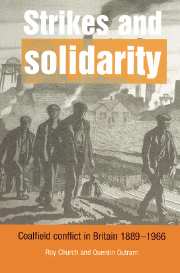Book contents
- Frontmatter
- Contents
- List of figures and tables
- Preface
- List of abbreviations
- 1 Interpreting coalfield conflict: focus and formulations
- 2 Tradition and modernity: the mining industry 1889–1940
- 3 Employers and workers: organizations and strategies
- 4 Employers and workers: ideologies, attitudes and political orientations
- 5 Configurations of strike activity
- 6 Strike participation and solidarity before 1912
- 7 Strikes, organization and consciousness in 1912 and after
- 8 Conflictual context? The ‘isolated mass’ revisited
- 9 Mining and modernity: size, sectionalism and solidarity
- 10 The foundations of strike propensity
- 11 Miners and management: agency and action
- 12 Industrial relations and strikes after nationalization
- 13 International perspectives
- 14 Myths and realities: strikes, solidarity and ‘militant miners’
- General appendix
- List of references
- Index
8 - Conflictual context? The ‘isolated mass’ revisited
Published online by Cambridge University Press: 04 December 2009
- Frontmatter
- Contents
- List of figures and tables
- Preface
- List of abbreviations
- 1 Interpreting coalfield conflict: focus and formulations
- 2 Tradition and modernity: the mining industry 1889–1940
- 3 Employers and workers: organizations and strategies
- 4 Employers and workers: ideologies, attitudes and political orientations
- 5 Configurations of strike activity
- 6 Strike participation and solidarity before 1912
- 7 Strikes, organization and consciousness in 1912 and after
- 8 Conflictual context? The ‘isolated mass’ revisited
- 9 Mining and modernity: size, sectionalism and solidarity
- 10 The foundations of strike propensity
- 11 Miners and management: agency and action
- 12 Industrial relations and strikes after nationalization
- 13 International perspectives
- 14 Myths and realities: strikes, solidarity and ‘militant miners’
- General appendix
- List of references
- Index
Summary
Locality and community: illustrations, models and critiques
The background of shared experience which lay behind miners' view of themselves and influenced their actions was formed partly by the workplace and partly by the locality. In this chapter we examine the influence of the structures of the colliery locality on strike activity, before returning to the impact of the structures of the workplace in chapter 9. Structures are frequently more amenable to measurement than the sometimes transient elements of consciousness and action. Accordingly this chapter and the next two use statistical methodologies to investigate the variations in miners' strike activity. A technical account of our procedures is provided in the appendices to these chapters; the text gives a less formal exposition of our investigations.
In chapter 2 we were concerned to stress, in contrast to much recent writing, the modernity of many aspects of the British mining industry. However, in one respect it is undeniable that the industry remained traditional and that ‘modernity’ passed it by. This was in its pattern of settlement and in the communities that established themselves in those localities. The ‘modern’ locality strictly segregates work and leisure, production and consumption. Workplace and residence are geographically separated, often by considerable distances, and are separate also in the structures of ownership: employers and landlords are distinct people or organizations with few or no links each to the other, formal or informal; workers who own none of the means of production may nevertheless own the house which is their major asset and the basis of their consumption.
- Type
- Chapter
- Information
- Strikes and SolidarityCoalfield Conflict in Britain, 1889–1966, pp. 132 - 158Publisher: Cambridge University PressPrint publication year: 1998



